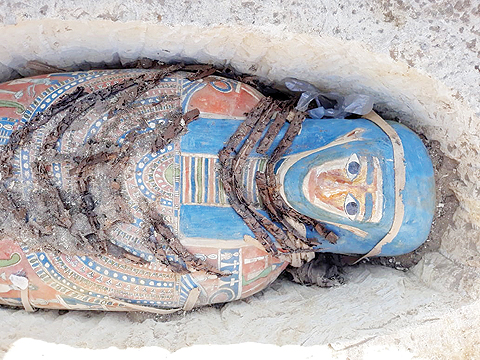 DAHSHUR, Egypt: Handout picture released yesterday shows a newly-uncovered mummy at a pyramid complex south of Cairo. - AFP
DAHSHUR, Egypt: Handout picture released yesterday shows a newly-uncovered mummy at a pyramid complex south of Cairo. - AFPCAIRO/JERUSALEM: Egyptian archaeologists have discovered eight mummies dating back over 2,300 years at a pyramid complex south of Cairo, authorities said yesterday. "The Egyptian archaeological mission working at the south eastern area of King Amenemhat II's pyramid in Dahshur Necropolis has uncovered a number of ancient burials with eight coffins," the antiquities ministry said in a statement. The mummies, dating from the Late Period of ancient Egypt, are "covered with a layer of painted cartonnage in the form of a human", the statement said. "Three of them are in good condition."
Cartonnage, a material often consisting of a mixture of linen or papyrus and plaster, was frequently used to cover mummies. The ministry said it planned to eventually put the mummies and the limestone sarcophagi they were found in on display at museums set to be built in the resort hubs of Hurghada and Sharm el-Sheikh. The Dahshur complex, some 30 km south of Cairo, was a major royal burial site that boasts the well-known "bent pyramid" of King Snefru. In April 2017, the remains of an Egyptian pyramid built around 3,700 year ago were discovered at the complex.
Meanwhile, the Israel Antiquities Authority unveiled what it said was a rare 9,000-year-old stone mask linked to the beginnings of agricultural society. The pink and yellow sandstone object was discovered in a field at the Jewish settlement of Pnei Hever, in the Israeli-occupied West Bank, said the IAA. The artifact was handed in to authorities in early 2018. "The mask is very naturalistic in the way it was made," said IAA archaeologist Ronit Lupu. "You can see the cheekbones, you can see a perfect nose. It's a rare mask," she told AFP. "The last one that we know was found 35 years ago. It's an amazing find, archaeologically speaking."
The West Bank is a Palestinian territory occupied by Israel in the 1967 Six-Day War. Disputes over ownership of artifacts discovered there are just part of the long-running conflict with the Palestinians over the land. The IAA placed the mask at a pivotal period in Neolithic culture. "Stone masks are linked to the agricultural revolution," the authority said in a statement. "The transition from an economy based on hunting and gathering to ancient agriculture and domestication of plants and animals was accompanied by a change in social structure and a sharp increase in ritual-religious activities."
Among such activities, it said, was ancestor worship. "It was part of the ritual and retention of family heritage that was accepted at the time," the statement said. "Stone masks, such as the one from Pnei Hever, are similar in size to the human face, which is why scholars tend to connect them with such worship." - AFP










